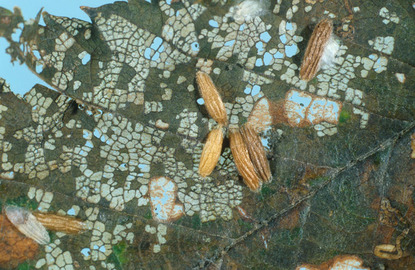Introduction

Insects that eat the parenchyma of the leaves, leaving behind the skeleton of veins are known as skeletonizer insects. They include many lepidopteron larvae. In their life as a caterpillar they are one of the major concerns for farmers and harvesters. They grow within the field and feed on the leaves. It is not easy to find them in a field until you see leaves with only skeleton of veins left. They are a type of moth. In large amounts, different types of these moths are found in the areas of North America. Just within North American there are approximately twelve thousand various types of moths such as black beetles’ skeletonizer, Slug Sawfly skeletonizer, grape leaf skeletonizer, etc. Grape skeletonizer is largely spread around America as there are countless grape fields and some people even grow grapes in their backyards. It is a commonly found specie in Florida. Palm skelotonizer is another moth that feeds on seventy eight types of palm leaves. To save your leaves you need to get rid of them.
Step 1
Here are a few important facts about the skeletonizer insects so you can identify whether what you are dealing with is a skeletonizer insect or not. Moth of grape larvae is 1.5 inches long as a caterpillar with a yellow body base and black patters on it. It grows up to be a black moth with antennas the shape of a comb but its body size remains 1.5. The length of its wings is twice its body size. All skeletonizers grow on the leaves; they feed from the lowest leaf because of which they are not apparent right away.
Step 2
The best way to get rid of skeletonizer insect if you are a home owner is to identify their presence early on by keeping a good eye on the leaves at the bottom of the plant. They can be removed by rubbing a wet sponge on the leaf or washing them away with high pressure of water. This will stop them from causing any more damage.
Step 3
For farmers who commercially grow crops it is very important to get rid of the skeletonizer insect. Using the appropriate chemical to remove the insects is very important therefore before choosing any chemical consult a professional who deals with chemical work. By spraying the suitable chemical the insects will die and fall off the leaf, preventing further damage. Another way is to introduce some parasites who feed on larvae in the field, but this technique may not be very effective. If the presence of larvae is detected sooner, then wash them off or remove them through burning in an effective way before the larvae spreads throughout the field.
Tips

Skeletonizer insects may grow up to be a beauty of nature but they are harmful to the source of your food and oxygen and most importantly your income. The increasing species of skeletonizer insects have created a burden for the import and export industries that deal with crops. Therefore they are to be controlled at all costs.
Sources and Citations
http://entnemdept.ufl.edu/creatures/fruit/grapeleaf_skeletonizer.htm - intro
http://arizonabeetlesbugsbirdsandmore.blogspot.com/2010/09/hockeria-rubra-and-host-harrisina.htmlhttp://okeechobee.ifas.ufl.edu/Skeletonizer.pdf